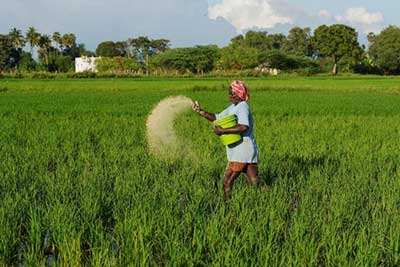Date: 03/02/2023
Relevance: GS-3: Government Budgeting
Key Phrases: twin crisis in agriculture, Food subsidy, fertilizer subsidies, minimum support price, National Mission on Natural Farming, Agriculture Accelerator Fund, PM-Pranam, GOBARdhan, Bhartiya Prakritik Kheti Bio-Input Resource Centres.
Why in News?
- Globally, there is a twin crisis in agriculture: in food and fertilizers. On the one hand, there are fears of a fall in the global production and availability of food. The rise in food inflation has been an area of serious concern for the government and the Reserve Bank of India.
- On the other, global fertilizer prices have risen by about 200% over the past two years. Consequently, the prices of fertilizers and other farm chemicals in India have also shot up.
Growth in the Agriculture sector:
- The Union government has failed to double the real incomes of farmers between 2015 and 2022.
- Official data show that real incomes from cultivation have fallen in absolute terms after 2015.
- Between 2020-21 and 2022-23, annual growth rates in agriculture and allied sectors have been stagnant between 3% and 3.5%.
- Agricultural exports have risen, but the impact of this has been insignificant outside a handful of commodities.
Objectives of the Budget formulation:
- The objectives of the Budget could be formulated as two-fold:
- It must have protected farmers and consumers from the food and fertilizer crises.
- It must have taken steps to raise net incomes from cultivation.
Disappointing Allocations:
- Food Subsidy:
- The restructuring of the food distribution guidelines, which effectively ended a part of the free supply of food grains under the Pradhan Mantri Garib Kalyan Anna Yojana, was a disappointment even prior to the Budget.
- The Budget has reaffirmed that stance and cuts food subsidy from ₹2.87 lakh crore in 2022-23 (RE) to ₹1.97 lakh crore in 2023-24 (BE).
- Fertilizer Subsidies:
- Fertilizer subsidies have also been cut from ₹2.25 lakh crore to ₹1.75 lakh crore.
- The cut in fertilizer subsidies will increase the costs of cultivation for farmers, but there is no amelioration to be expected from a compensatory rise in output prices.
- There has been no solace on the production front too. Yields in agriculture remain low. Rising fertilizer prices have led to lower consumption of fertilizers in farms, leading to imbalanced nutrient application and even poorer prospects of yield rise.
- Overall Impact of Subsidy Cut:
- In effect, these cuts will expose farmers to the vagaries of the global market and render the economics of agriculture more fragile.
- Landless households in rural areas are also likely to be affected adversely, as the allocation for the Mahatma Gandhi National Rural Employment Guarantee Scheme has been cut from ₹73,000 crores in 2022-23 (BE) to ₹60,000 crore in 2023-24 (BE).
- The rise in minimum support prices between 2020-21 and 2021-22 just covered for the rise in input costs and did not leave any space for higher net incomes.
- The government, while decreasing the fertilizer subsidies, has been promoting variants of “natural farming”. The Budget has even allocated ₹459 crores to a new National Mission on Natural Farming. But natural farming has no scientific validation and is likely to reduce crop yields by 25-30%.
Capital Expenditure:
- Capital investment is required in agriculture not just for irrigation but also to build/improve agricultural markets (mandis).
- The total capex of the government in 2022-23 was ₹7.5 lakh crore, but allocation under the capital accounts of crop husbandry, animal husbandry, dairy, and fisheries was just ₹119 crore. In 2023-24, this is expected to fall to ₹84.3 crores.
- Under the capital account of irrigation and flood control, the budgeted allocation in 2022-23 was only ₹350 crore, which is slated to fall to ₹325 crores in 2023-24.
- The Agriculture Infrastructure Fund (AIF) is another much-touted scheme. The budgeted allocation for AIF in 2022-23 was ₹500 crore, of which only ₹150 crores was spent. In 2023-24, the allocation of ₹500 crore has been retained.
Fragmented Allocations:
- The budget announcements on agriculture are all fragmented allocations thinly spread across diverse departments with only an indirect or marginal impact on the agricultural sector.
- Good examples are the Agriculture Accelerator Fund, PM-Pranam, GOBARdhan, Bhartiya Prakritik Kheti Bio-Input Resource Centres, Mishti, and Amrit Dharohar.
- There was not any explicit allocation for millets other than in upgrading a Centre for Excellence in Hyderabad.
- There was yet another announcement on a targeted investment of ₹6,000 crores under the Pradhan Mantri Matsya Sampada Yojana, but the actual increase in allocation in the Budget papers is only ₹ 121 crore.
Conclusion:
- Despite efforts to address the issues facing the agriculture sector, the budget fails to address the most pressing problems in Indian agriculture.
- There is a need for a broad and concrete vision according to the potential of the agriculture sector, along with scientific methods to decide the quantum and direction of budget allocations.
- By addressing these issues, the agriculture sector has the potential to become more sustainable and contribute to economic growth and development.
Source: The Hindu
Mains Question:
Q. What are the reasons for the twin crises in agriculture—in food and fertilizers? What measures should the government take to avoid a prolonged food crisis?







